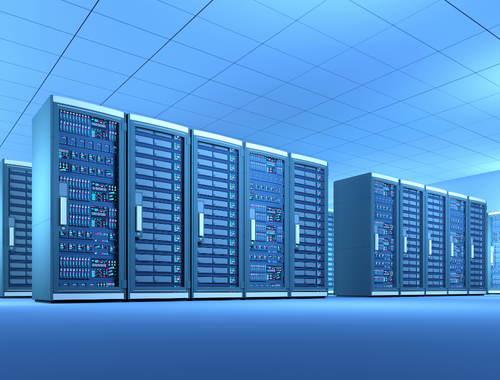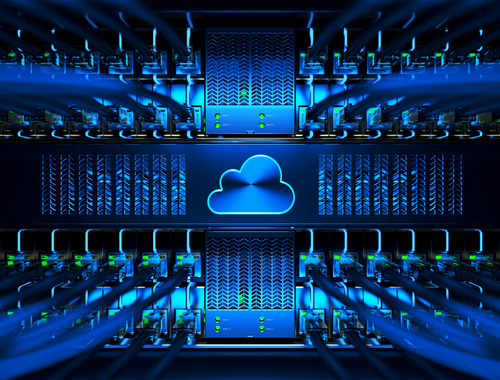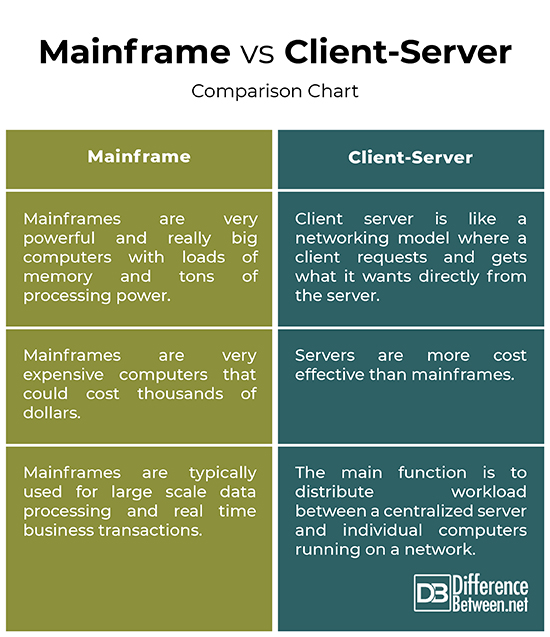Difference Between Mainframe and Client Server
Today, mainframes are undoubtedly among the most powerful computing machines, along with servers and super computers. Government organizations and large scale enterprises use such machines to handle processing at massive scale. These are very powerful machines capable of handling substantial amounts of data at very fast speeds. Client-server networking is something we use on a daily basis but do not fully understand, at least not the average layman person. Let’s take a detailed look into the two. Keep reading to know more.

Mainframe
Mainframe is like a really big, cabinet sized computer that is insanely fast and powerful, and capable enough to support numerous workstations or peripherals. They are kind of high-performing computing machines with loads of memory and processors that can process complex to highly complex calculations and transactions in real time in a matter of seconds. Mainframes are super-sized computers that can manage terabytes of data and information In databases. The ZSeries mainframe computer from IBM is probably the most popular mainframe computer in use. Large scale businesses and today rely on mainframes to manage large-bandwidth communications and support tons of users and application programs.

Client Server
Client-server is a distributed application architecture that distributes tasks or workloads between a client, the one who requests services or resources and server, the one that provides services or resources. Client-server, as the name suggests, is a networking model where clients and servers interact or communicate with each other directly. A client requests for some service or resource provided by the server and the server responds back to the client’s requests. Remember that there can be multiple clients connected to a single server. We use this networking daily but do not fully comprehend its intricacies. Common examples of client-server model include DNS, FTP, web browsers, etc.
Difference between Mainframe and Client Server
Definition
– Mainframes are very powerful and really big computers with loads and loads of memory and tons of processing power. Mainframes are specialized computing machines that are particularly designed for large scale businesses and government organizations. The client-server model is like a computer system in which a central server provides resources and services to a number of workstations in a network. Client server is like a networking model where a client requests and gets what it wants directly from the server.
Function
– Mainframes are systems with large storage capacity and lots of processing power, and are specifically designed for large scale data processing, centralized computing for ecommerce hosting and development. They are used by large scale businesses for critical computing tasks and real time business transactions. The function of a server is to serve all requests from clients for processing, store data or information, or provide a database to run. The major function of a client-server system is to distribute workload between a centralized server and individual computers running on a common network.
Money
– One of the major deciding factors is the cost. In terms of pricing, mainframes are very large computers that could easily cost you thousands of dollars – far more than what you might pay for a server. And that’s not even everything; besides the hardware and software cost there are other major investments involved such as hardware support and maintenance costs, software licensing costs, and more. In addition, you need experienced people to oversee daily operations of a mainframe. Servers, on the other hand, are more cost effective than a full-fledged mainframe computer.
Mainframe vs. Client-Server: Comparison Chart

Summary
Mainframes are basically really large, powerful, high-speed computing machines that are capable of handling multiple tasks and solving complex calculations concurrently. They are high-performance machines that are used commercially by large scale enterprises or government organizations to handle critical applications such as bulk data processing, real time transaction processing, etc. A client-server model is a different story; it’s a distributed application architecture of a computer network in which several clients request and receive services from a centralized server.
Is a mainframe computer a server?
Mainframes are really big data servers that are specifically designed to process and handle billions of transactions on a daily basis with utmost reliability and security.
Is mainframe better than server?
Technically, mainframe is an ideal computing machine for performing big data analytics, large scale data processing, and web application processing, and more. Many government agencies still use mainframes to store data.
What advantages does client/server computing have over mainframe computing?
The client/server computing enables clients and servers to follow a common communication protocol so that they can interact with each other directly and easily. Mainframes are really large yet powerful computers used in large organizations for handling mission critical applications.
What are the 3 examples of mainframe computer?
Examples of mainframe computers include the IBM ZSeries mainframe computer, the UNIVAC, and the ASCC (Automatic Sequence Controller Computer).
What do you mean by Client Server?
Client-server is like a computer system where a client requests and gets what it wants directly from a centralized server.
What is the difference between client and server?
Client is the one who requests services or resources and server is the one that provides that services or resources over a network.
What are the technical differences between a server and a client machine?
A client machine is like a personal computer with basic hardware specs and a server machine is a system that authorizes the clients’ requests and provides them with requested services or resources.
What is client/server example?
Common examples of client-server model include web browsers, DNS, FTP clients, web applications, etc. Web browsers are the best example of a client-server relationship.
- Difference Between Caucus and Primary - June 18, 2024
- Difference Between PPO and POS - May 30, 2024
- Difference Between RFID and NFC - May 28, 2024
Search DifferenceBetween.net :
Leave a Response
References :
[0]Ingeno, Joseph. Software Architect’s Handbook: Become a Successful Software Architect by Implementing Effective Architecture Concepts. Birmingham, United Kingdom: Packt Publishing, 2018. Print
[1]Chelliah, Pethuru Raj, et al. Architectural Patterns: Uncover Essential Patterns in the Most Indispensable Realm of Enterprise Architecture. Birmingham, United Kingdom: Packt Publishing, 2018. Print
[2]Chevance, René J. Server Architectures: Multiprocessors, Clusters, Parallel Systems, Web Servers, Storage Solutions. Amsterdam, Netherlands: Elsevier, 2004. Print
